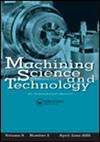Mitigation of cutting point deviation by generating provisional corrugations during milling of thin walls
IF 2.6
4区 工程技术
Q2 ENGINEERING, MANUFACTURING
引用次数: 0
Abstract
Abstract The nominal cutting contour for the thin wall deviates in response to the cutting forces during the end milling process. Elimination of mass in the milling process links to loss of stiffness, which favors the wall to deflect and promote error. This article proposes a novel way of generating rigidity during the process of milling. The tool paths were drafted to mill away mass in the central region and make corrugations at the edges simultaneously. This approach mitigated the thin wall deformation. Comparison experiments were conducted to analyze between open wall conventional type (OWC) and end corrugated pillar type (ECP). Force polygons were constructed to evaluate the effectiveness of machining. The experiments resulted in 36% more effectiveness in up milling and with 93% in down milling. An increase in the cutting effectiveness exhibited error-free and minimized cutting point deviation at the top of the wall. Eventually, the error diminished as the tool traversed to the bottom edge of the wall.通过在铣削薄壁时产生临时波纹来减轻切削点偏差
在铣削过程中,薄壁的标称切削轮廓随切削力的变化而发生偏离。铣削过程中质量的消除与刚度的损失有关,这有利于壁面偏转并促进误差。提出了一种在铣削过程中产生刚性的新方法。拟定了刀具轨迹,在中心区域磨去质量,同时在边缘形成波纹。这种方法减轻了薄壁变形。对开壁常规型(OWC)和端部波纹柱型(ECP)进行了对比试验分析。构造力多边形来评价加工的有效性。实验结果表明,上磨效率提高36%,下磨效率提高93%。切割效率的提高表现为在壁面顶部无误差和最小化切割点偏差。最终,随着工具移动到井壁的底部边缘,误差逐渐减小。
本文章由计算机程序翻译,如有差异,请以英文原文为准。
求助全文
约1分钟内获得全文
求助全文
来源期刊

Machining Science and Technology
工程技术-材料科学:综合
CiteScore
5.70
自引率
3.70%
发文量
18
审稿时长
6 months
期刊介绍:
Machining Science and Technology publishes original scientific and technical papers and review articles on topics related to traditional and nontraditional machining processes performed on all materials—metals and advanced alloys, polymers, ceramics, composites, and biomaterials.
Topics covered include:
-machining performance of all materials, including lightweight materials-
coated and special cutting tools: design and machining performance evaluation-
predictive models for machining performance and optimization, including machining dynamics-
measurement and analysis of machined surfaces-
sustainable machining: dry, near-dry, or Minimum Quantity Lubrication (MQL) and cryogenic machining processes
precision and micro/nano machining-
design and implementation of in-process sensors for monitoring and control of machining performance-
surface integrity in machining processes, including detection and characterization of machining damage-
new and advanced abrasive machining processes: design and performance analysis-
cutting fluids and special coolants/lubricants-
nontraditional and hybrid machining processes, including EDM, ECM, laser and plasma-assisted machining, waterjet and abrasive waterjet machining
 求助内容:
求助内容: 应助结果提醒方式:
应助结果提醒方式:


